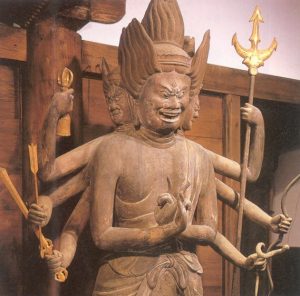
I feel passionately about the arts as a major mode of activism and resistance. Through them, artists creatively explore our complex political and emotional world. From time to time, I feature the work of Indigenous artists to honor their contributions, hold up their resistance and resilience, and celebrate exquisite craft and artistry such as that of Jamie Okuma (Shoshone-Bannock/Luiseno).
I was fortunate to attend the Duality art show at the Longmont Museum last year, curated by Gregg Deal and featuring several beaded works by Jamie Okuma. Beading since childhood, she has become a renowned haute-couture designer, a beloved and highly respected artist who combines tradition with modernity in her own gorgeous, funky, and unique ways. A high level of craftsmanship pervades all her art. Her beaded work exacts long hours and the results show it, her pieces being collected by museums, galleries, and private collectors.

I’m particularly drawn to fashion as a three-dimensional, soft-sculpture medium that depends on the human form for its proper exhibition. Fashion includes movement, change, and interaction. It also involves mystery and surprise. It is a living art as the difference between viewing a piece on a mannequin and on a live human being is palpable.
My grandmother was a painter, so art was just a part of life since birth. But it was really when I began dancing at pow wows [that I became interested in being a designer]. The first one I attended was at my grandmother’s reservation, the Fort Hall Indian Reservation in Idaho.
My very first time dancing I was in street clothes, but I’d seen everybody’s beautiful outfits and knew that’s what I wanted to do. It requires a lot of work—beadwork, sewing; everything is made by yourself and your family. So that’s basically where it started, so I could get out in the pow wow circle and dance. I’ve pretty much had a needle and thread in my hand ever since. (Jamie Okuma in InStyle magazine)
Jamie once eschewed the qualifier Native, preferring to be known simply as a designer. She felt the term limited her work. However, now she proudly defines herself as a Native fashion designer, fully owning her ancestry and cultural history. This helps to teach the world that Native peoples are far from dead and gone, a pervasive and unfortunate view in the world, part of the romanticization as well as erasure of Native American and Native Canadian cultures.
This short video is well worth a watch to hear from the artist designer herself and see her powerful art in motion on the runway.
The duality of Indigenous existence is a rich well of experience, trauma, identity, survival, and beauty all rolled into one. Each native artist represented here . . . shares the unique experience of being Indigenous in North America in the 21st century. To be in your homelands, where your people for multiple millennia have lived and yet be invisible to the majority of people who now reside here is a unique if not difficult situation. To articulate oneself through art is an incredible tool of freedom. (Excerpt from the “Artist & Curator Statement” by Gregg Deal on the wall of the Duality group show in Colorado, 2023, Longmont Museum)
It is no small act to take a coveted modern form, such as high-heeled boots and high-end purses, and use her own lineages’ methods of fine, painstaking beadwork to express her own personal style, as well as make a nonverbal commentary on the resilience of her people and the adaptability to modern time, place, and cultural trends. It shows not only resistance to assimilation and eradication, but a resilience and flourishing beyond biased expectations. Okuma has dressed celebrities, film stars, and politicians, including the US Secretary of the Interior Deb Haaland, demonstrating the interconnected power of the arts and political realms. She collaborates with popular musicians and proprietors of native art to promote the sales of native-designed and created textiles, music, home goods, and much more.

Okuma’s work is not merely beautiful, it speaks unflinchingly of historical persecution, genocide, and theft, through visual messaging, humor, and a unique juxtaposition of content and form. The exponential exposure of Native design, art, music, and initial involvement in the US speaks to the dire need for native peoples to receive their due restitution, in whatever ways are possible. One of these ways is through visibility and appreciation—not appropriation. There is a growing movement to support the Inspired Natives project, and not so-called “native-inspired” fashion, art, music, foods, experiences, and other kinds of goods. We have had far too much of that to the detriment of native people’s financial, mental, physical, and psychological well-being. This is just one reason why I feel so strongly about using my writing to raise up and celebrate Native arts. It is my sort of aspirational bodhisattva activity. Another is my profound admiration for and pleasure in experiencing these artists’ work, as it serves to uphold and honor their traditions, lineages, and prowess in their craft, as well as unique views of the future and what it may hold for art, more-than-human beings, the Earth, and the health of our human communities. May we strive to embody a Native view that all we know be recipients of loving care as, all our relations.
See more
Jamie Okuma: Native American Fashion Artist
We Can’t Talk About American Fashion Without Talking About Native American Designers (InStyle)
New Collaboration with Jamie Okuma, Renowned Fashion Artist! (Eighth Generation)
No Place Like Home, “Holyulkum”, 2018. (Crocker Art Museum)
Related features from BDG
How We Perceive and Are Perceived: Memory Map, the Art of Jaune Quick-to-See Smith
Indigenous Art Matters – The Bold, Contemporary Work of Artist Gregg Deal
Indigeneity and Dharma
Restoration and Justice: An Interview with Dr. Natalie Avalos on Indigenous Spirituality and Buddhist Allies














